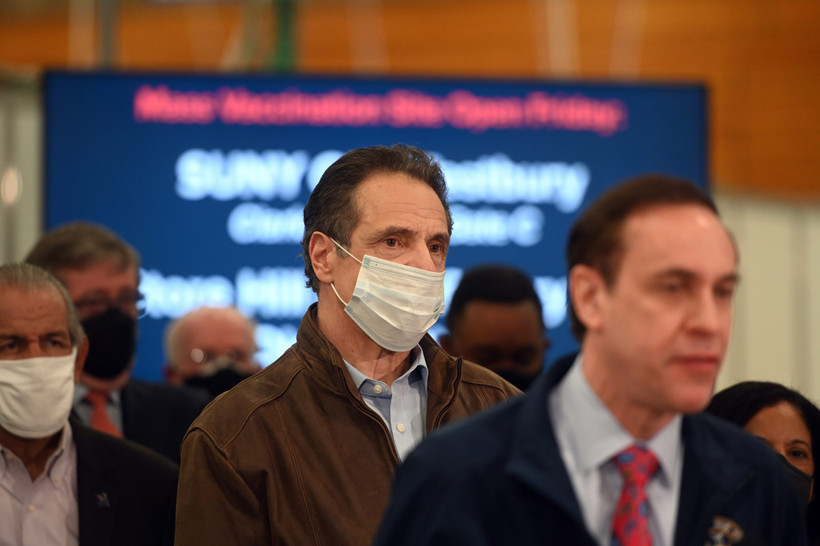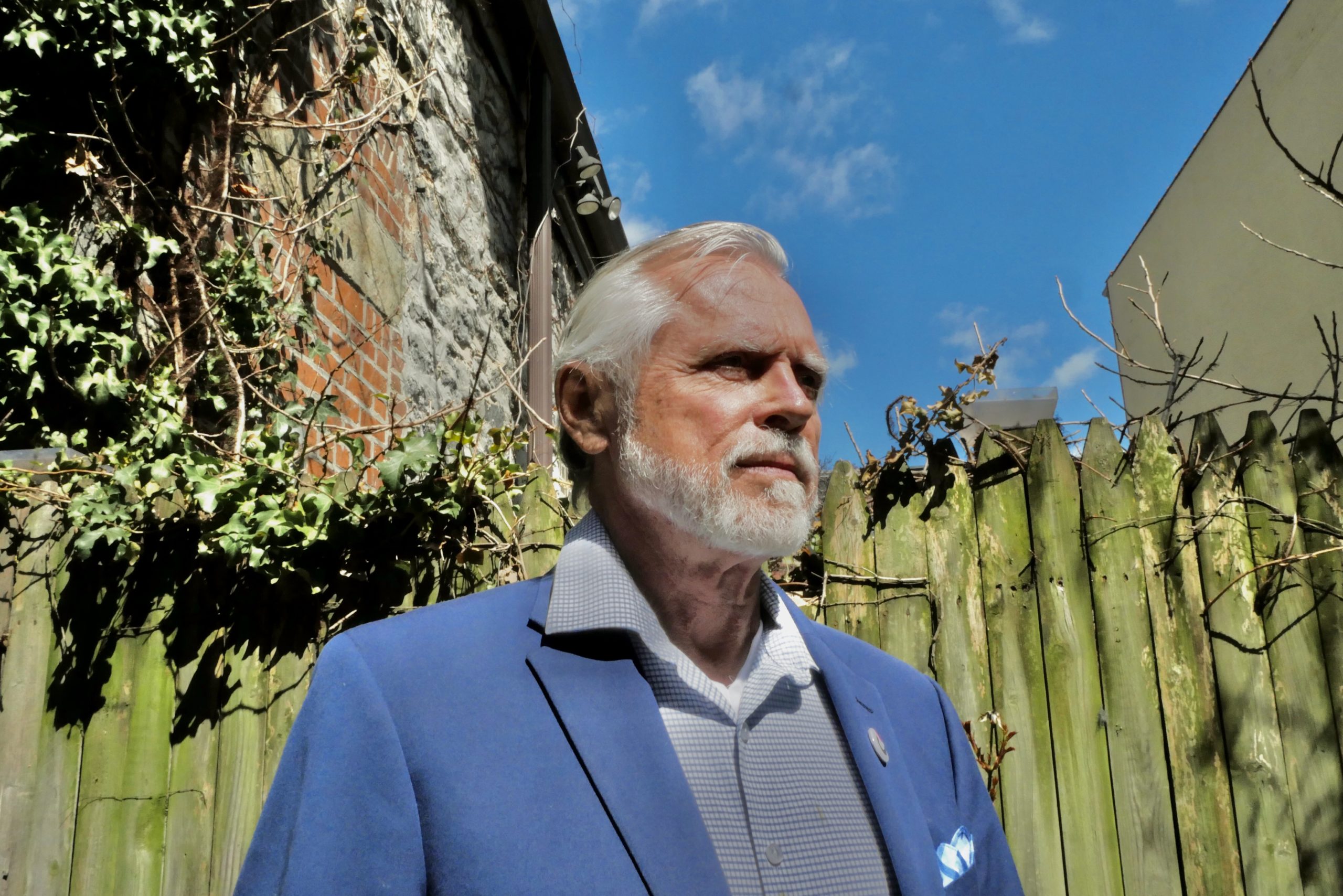Where are the Safe Injection Facilities Cuomo Promised for New York?
He committed three years ago to supporting safe injection sites for drug users — then reversed course, activists say. Now, they see a new chance to pressure the embattled governor.

This story was published in partnership with THE CITY.
Three years ago, safe injection facilities seemed on the verge of opening in New York.
City and state health departments were designing a pilot program for the facilities, where people who use illegal drugs can inject under medical supervision.
“It’s something we have the Department of Health working on, in concert with New York City,” Andrew Cuomo said at a 2018 gubernatorial debate.
Activists have lobbied the governor for years to authorize safe injection facilities, which are also known as safe consumption sites. Ahead of the election, several advocates said, the governor privately promised to green-light facilities in New York City and Ithaca.
Based on that assurance, organizers cancelled a planned civil disobedience, in exchange for a guarantee by Cuomo that he would authorize the pilot project after the election.
“The Governor gave his word that we will receive the Zucker authorization letter right after the election. All as a package to avoid our little party,” Charles King, the CEO of Housing Works, a social services nonprofit, wrote in an email to his staff at the time.
Yet following the election, the governor reversed course on the sites, advocates told New York Focus. Since then, the pilot program has floated in political limbo.
“All of a sudden, the governor just went away — slammed the door in our face,” said Ken Robinson, the now-retired executive director of Research for a Safer New York, a corporate entity set up to sponsor the pilot. “They quit talking to us.”
It became clear that the state had decided the sites were too politically risky, lawmakers said. Even as the opioid overdose crisis has deepened in New York in the last year, state health officials have stonewalled inquiries about the status of the pilot program.
New York State’s draft manual to open sites is ready at hand, but the governor’s sign-off has held up the facilities. Now, advocates are asking whether Cuomo’s political woes could clear the way for safe injection sites to open.
Initial Cautious Support
Fatal overdoses from opioids like heroin and fentanyl have spiked so dramatically in recent years that they have helped lower the American life expectancy.
In New York, official city and state data on death rates are lagging. But provisional CDC figures show a steady increase in fatalities since 2019.
Safe injection facilities currently operate in more than 100 cities around the world, but none has yet opened in the United States.
Experts say the sites prevent overdose deaths and reduce the transmission of infectious diseases like HIV. At-risk users are given a clean space to inject IV drugs under the supervision of trained staff, who may provide sterile equipment, health education, counseling, referrals and emergency medical care.
A drumbeat of news coverage drew attention to the overdose epidemic in 2017. That year, 1,487 New York City residents died from opioid overdoses — the seventh consecutive year that fatalities increased. Deaths leveled off from 2017 through mid-2019, and then began rising again, preliminary CDC data shows.
Increasingly desperate providers drew public attention to their underground harm reduction efforts. CNN’s Dr. Sanjay Gupta profiled the Washington Heights Corner Project, a syringe exchange program that was flouting drug laws to allow heroin injection in its bathroom.
Amid growing scrutiny of the crisis, the centers drew mounting support in 2018. That year, New York City released a long-delayed study on the feasibility of safe injection facilities — aka SIFs — commissioned years earlier by the City Council.
Cynthia Nixon, a socialist primary challenger to Cuomo, endorsed the sites as a public health measure. Even then NYPD Commissioner James O’Neill signaled his openness to the idea. Philadelphia had already approved a safe injection experiment of its own.
In response to Gupta’s story and mounting criticism, state health commissioner Dr. Howard Zucker signaled to advocates that the governor was willing to move the sites forward, according to King, whose advocacy group has led the push for SIFs at the state level.
Negotiating with then-counsel to the governor Alphonso David, advocates agreed to various terms. The sites would be called “overdose prevention centers,” not “safe injection facilities.” Reached by New York Focus and asked about King’s description of events, David, who left the Cuomo administration in 2019, declined to comment.
Housing Works provided New York Focus a December 2017 draft of the authorization letter which, according to King, the commissioner was waiting on Cuomo’s go-ahead to sign.
According to King, David also stipulated that in order to secure the governor’s sign-off, advocates would have to get the public support of Mayor Bill de Blasio.
That didn’t seem too challenging.
De Blasio-Cuomo Complications
Mary Bassett, then the city’s health commissioner, told New York Focus that the city had already been looking into the issue, without consulting the state.
Generally, Bassett said, “we didn’t do joint planning with them. We would seek alignment, for example, in tackling HIV. The whole idea of getting down to below 1,000 [HIV] cases was a statewide initiative. But the state funneled a lot of resources into HIV, and we weren’t getting those kinds of resources in response to the opioid epidemic.”
In responding to the overdose crisis, Bassett said, the city forged ahead with its own plans. “As everybody knows, the governor and the mayor have difficulties in their working relationship, and that colored the ability of the city to work with the state health department, as well,” she said.
Bassett emphasized the importance of the programs amid an upswing in opioid fatalities. As commissioner, Bassett first became interested in SIFs when she learned of an overdose prevention center in Vancouver, which provided “a very low-threshold pathway from a safe consumption site into treatment.”
“If you’re not alive, you can’t recover,” Bassett said. “You want to try and keep people alive, get them into treatment, and not punish them, which pushes people away.”
A Promise From Cuomo
In spring 2018, with the gubernatorial election in full swing, de Blasio announced his support for the centers. Instead of following suit, King said, the governor waffled.
Seeking to capitalize on growing momentum, organizers with Housing Works planned a civil disobedience at a gay pride breakfast in June 2018 where the governor was planning to accept the endorsement of prominent gay rights figures, including City Council Speaker Corey Johnson.
“We knew what the governor wanted with this breakfast was to rub shoulders with potential donors, and to varnish his image, including the appearance of his strong stance on public health,” Reed Vreeland, director of community mobilization at Housing Works, told New York Focus. “Holding up a mirror to the actual overdose death count on his watch, in that setting, would be a visceral juxtaposition.”
When news of that planned action reached the governor, King said, he got a call from David.
“Governor Cuomo had explicitly authorized him to communicate a promise to me that if we did not go forward with this planned action, the governor would authorize the commissioner signing this letter immediately after the November election,” King said. “But he asked that we hold off until then.”
Following the call with David, King said, he talked activists off the ledge, persuading them not to hold the protest.
And, at first, he thought the decision to quash the protest had paid off.
“I was on the phone with [Cuomo’s office on] the second floor, negotiating: Was this going to be a public announcement? Was it going to be something that quietly went through? Should this be announced by the governor as part of his World AIDS Day statement?” King recalled.
The opening of safe injection sites seemed imminent.
‘Second Thoughts’
Staff in the Department of Health even began designing policies and procedures for the centers, anticipating practical challenges they might face. How would sites handle demand at peak hours? What would staff job duties be?
Would users of IV drugs be permitted to inject each other? Where could participants leave bulky personal items, such as shopping carts? How would staff treat particularly vulnerable populations, such as pregnant women and teenagers?
Yet soon after the election, the governor’s staff went silent.
“All of a sudden, I got word from the second floor that the governor was having second thoughts about this,” King said.
 Charles King (Photo by Jason Scott Jones)
Charles King (Photo by Jason Scott Jones)Others who had been involved in planning the centers were also left out in the cold. John Barry, the director of Southern Tier AIDS Network, which had volunteered to host a site, said his calls stopped getting returned.
“As soon as he was elected, we heard no more about it. We inquired — we were persona non grata.”
The state Department of Health sent a statement to New York Focus: “We continue to explore all options to reduce opioid overdose deaths and combat addiction in New York State,” it reads.
“While we fully support efforts to reduce the harms caused by the opioid epidemic, we are also reviewing the most recent ruling in Philadelphia over supervised injection facilities and considering the impact it could have on efforts to launch similar facilities here.”
City Plan on Hold
Over the same period, New York City had been independently developing plans to open four sites.
“The city plan is basically turnkey and ready to go,” said Melissa Moore, New York state director of Drug Policy Alliance, an advocacy group. “The last remaining issue is that final approval from the state. The actual programs that would be involved in standing these up have been working together for multiple years.”
Denise Paone, a research director at the city’s health department, confirmed that the city is waiting on state action.
“There are two pathways they could take — administrative action, which would be similar to what they did to start syringe exchange programs in NYC in 1992, or to move forward with one of the bills. And so, that is completely up to the state,” Paone said.
Paone said that she does not know whether the governor supports opening the sites.
Syringe exchanges, also a controversial public health measure when they were first introduced, began as part of a small-scale research pilot program authorized by the state health department.
As the AIDS epidemic ravaged New York in the 1980s, activists with groups like ACT UP ran underground needle exchange programs.
Providing access to clean syringes had been proven to decrease the spread of HIV, but it was not until 1991 that the state health commissioner agreed to issue waivers to allow the exchanges to operate. That decision drew criticism from the Bush administration, which called the programs “wrong on moral grounds.”
They quickly took root after public health data showed their life-saving potential. Advocates hope for a similar outcome for a SIF pilot program.
The city could move to open the centers unilaterally, but many supporters worry that approach would be too vulnerable to federal opposition. Activists are currently lobbying President Joe Biden to direct the Justice Department to drop a Trump-era lawsuit against a program in Philadelphia, which attempted to open a site despite stiff opposition from federal prosecutors.
The city’s feasibility study argued that the governor’s approval would add a necessary layer of protection from potential legal challenges.
Cuomo has also pointed to potential legal obstacles and to the federal government’s opposition to the sites.
In 2019, then-President Donald Trump’s Justice Department sued a Philadelphia-based nonprofit attempting to open a safe injection site. Yet, following a court’s favorable ruling on the sites, Cuomo continued to warn of legal obstacles, said Jasmine Budnella, campaign coordinator at VOCAL-NY.
“Cuomo was standing up to Trump for everything, in the press,” Budnella said. “Throughout the Trump administration — even through COVID — his Emmy-winning press conferences have been painted as ‘He’s the other side of Trump.’ Yet, on this issue — on anything that has to do with people who use drugs, and saving people’s lives through evidence-based policies — Cuomo sides with the opposition.”
A New Opportunity?
Elected officials who support the sites say their requests to the state Department of Health — in writing and in person — have largely fallen on deaf ears, even before the COVID crisis and accusations of pandemic mismanagement and sexual harassment besieged the governor.
“I’ve asked Dr. Zucker, I’ve asked many people what’s going on with safe consumption spaces — and it’s dead silent,” said Assemblymember Linda Rosenthal (D-Manhattan), who was chair of the Committee on Alcoholism and Drug Abuse until this year.
Rosenthal said she has sent multiple unanswered letters inquiring about the delay to Zucker.
The last time Rosenthal encountered Zucker in Albany was after a news conference in early 2020. “I saw him leaving the room, and I asked him, ‘Where are we on that? What’s with signing off on the papers and commencing the program?’ And he said, ‘Oh, I can’t talk about it now.’”
“I was like, ‘Why not?’ and he just sort of had to run away,” she recalled. “He sort of indicated, ‘I’m up to here with planning COVID issues.’ But even if there weren’t COVID, I think they wouldn’t be interested in discussing it now. Maybe it doesn’t poll well.”
Rosenthal and Sen. Gustavo Rivera (D-The Bronx), who chairs the Senate Health Committee, are sponsoring legislation to authorize the centers.
But the state could use ordinary regulatory powers to authorize the centers without waiting for the bill to pass, Rivera noted.
“They have the ability to do this without the legislation, and as they have committed to do it as a pilot program, I would hope that they would,” he said. “They haven’t, yet.”
 Drug policy activists carry a pop-up safe injection site in front of Governor Cuomo’s NYC office in November 26, 2018 (Photo by Erik McGregor)
Drug policy activists carry a pop-up safe injection site in front of Governor Cuomo’s NYC office in November 26, 2018 (Photo by Erik McGregor)Many advocates expect the Biden administration to be friendlier to the sites.
Rob Kent, former counsel at the state Office of Addiction Services and Supports, is part of Biden’s team on addiction and drug use, which some advocates say is an encouraging sign.
However, Rivera acknowledged, “It is a policy area where deep, deep stigma still exists.”
Although both SIFs and needle exchanges are part of a broader strategy of harm reduction — minimizing risks around drug use, rather than insisting on sobriety — SIFs can carry negative public perceptions about quality of life for drug users. Polls have found that the public worries SIFs could disincentivize seeking treatment.
The retrenchment from the governor has made some harm reduction advocates wary of expending limited political resources on an issue that remains so charged.
“It’s about political capital,” said Pedro Mateu-Gelabert, an opioid researcher at CUNY Graduate School of Public Health. “If opening 10 new needle exchange programs has the same cost of political capital as opening a safe injection room, in my humble opinion, I think the safe needle exchange programs located across the city will be epidemiologically more effective than that one safe injection room.
‘We Can’t Wait’
Some advocates say the tide might be turning, as the coronavirus crisis and switch to telehealth have given rise to more public opioid overdoses in New York. The New York City Fire Department’s use of Narcan treatment—an emergency overdose response — spiked from 4,825 in 2019 to 6,432 in 2020.
At a mayoral forum last week, all candidates except former Citibank executive Ray McGuire said they endorse opening the sites. “Overdose prevention centers are something that is proven to work around the world,” city Comptroller Scott Stringer said.
Changing public opinion has made the sites more politically palatable: Between 2018 and 2020, the number of New Yorkers who support funding supervised injection sites rose from 41% to 48%, a recent poll found.
Budnella says SIF advocates are looking to capitalize on the momentum and push for the sites, as a flurry of scandals have weakened the governor, whose authorization remains the roadblock to safe injection sites.
But perhaps, she added, the city should move ahead unilaterally — even if that strategy involves added legal risk.
“A lot of us are like, hey, it’s time that the city just moves without Cuomo,” Budnella said. “We can’t wait any longer.”




